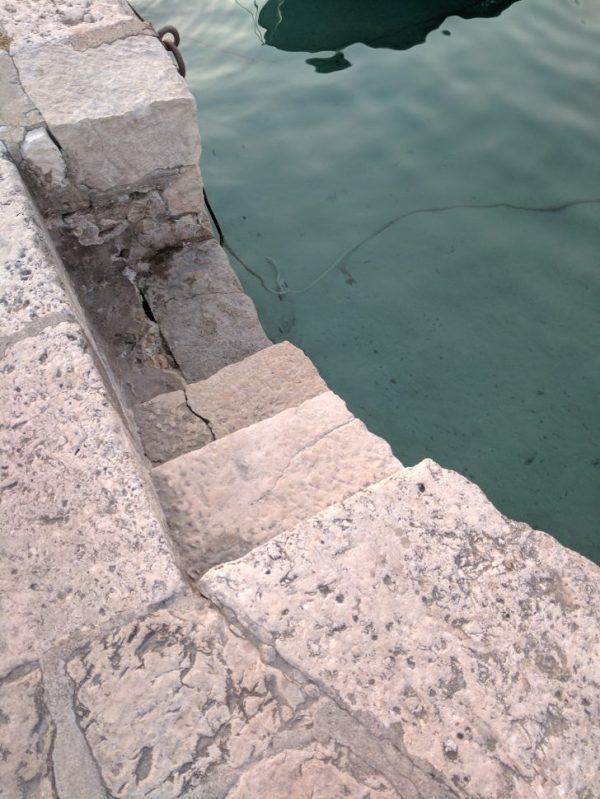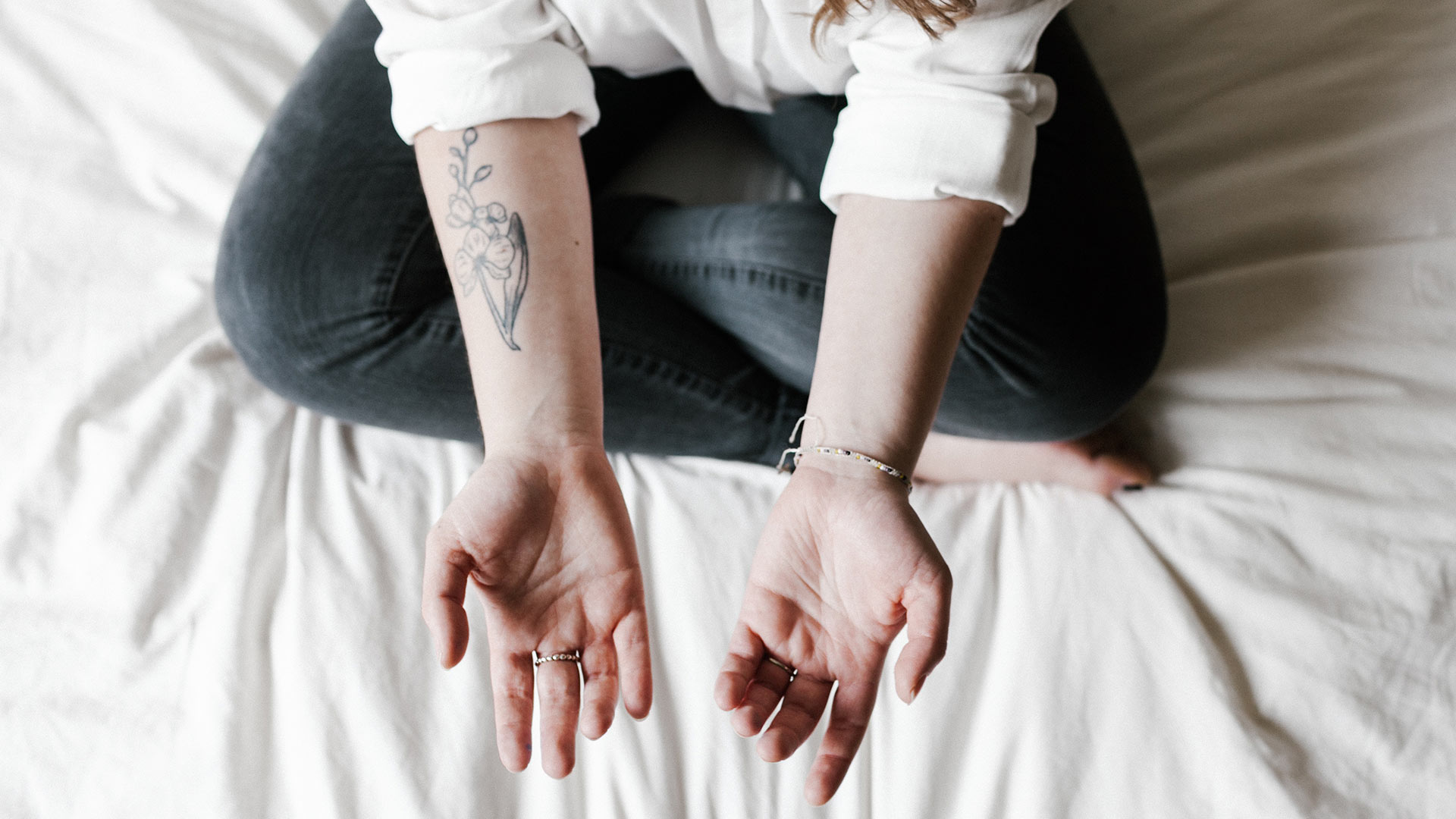When we internalize the assumptions and biases of the dominant culture, we hunker down in our places of privilege and ostracize those who are different. Here, MA in Counseling Psychology student Lindsay Braman writes about how a crumbling church and open water in Croatia invited her to honor her body, and the bodies of others, in a way that defies the shame-based messages of our culture. This post originally appeared over at Red Tent Living.
In Zadar, Croatia there is a thousand-year-old church that sits crumbling on the edge of the Adriatic Sea. Embedded in its foundation are countless broken artifacts, altars, and columns from the pagan temple that once stood in its place. It was only a few meters from this church where I swam in open water for the first time. There, the intersection of city and sea is mediated by an aging sea wall with stone steps that sink into the turquoise water of the Adriatic. As I descended these steps, I felt the rush and swell of open water and my own heart leaping into my throat as I slipped from the lowest step into the embrace of the sea.

Days later I returned home to Seattle, where brooding grey replaced brilliant blue and that church with its foundation of ruins receded to memory. And yet, in this season of #metoo, of marginalized voices breaking through, and of watching the Church teeter precariously between closing ranks and unfurling into the heavy work of lament, I think often of the church built on ruins and the sea that embraced me when I took a deep breath and chose to do the thing I feared: exist in my body.
For my body, descending the steps in my bathing suit on the seawall packed with rowdy young European tourists felt far riskier than swimming alone in open water: I am a fat woman. No stranger to catcalling’s weight-shaming counterpart: “fatcalling,” existing in my body comes with a cost, and overt experiences of body shame remind me of what often remains unspoken. For my body, freedom costs. I spent three days in that city before deciding I was willing to pay the price.
I am grateful to be a part of a community that has challenged me to enter conversations around the areas where I am privileged. I am being trained to consider race, culture, sexual orientation, gender identity, and socioeconomic status in every professional conversation I engage. Growing competency to engage these issues with integrity is absolutely critical to dismantling individual and systemic oppression—but my body asks: will we say we are done, there? Or will we enter the difficult work of examining our dis-ease about bodies in order to make space for diverse bodies, like mine? Will we stop and notice how thin-ideals are so internalized that privilege could permit many of us to live a lifetime without considering how they inform the ways we engage with persons who have bodies very different from our own?
For most of my life I believed the message coming at me from all directions that said that my body size was something with a moral value: bad. I believed, as stigma dictated, my body was evidence of a lack of willpower. I did not know that studies that look at the long-term effects of diets show that nearly all bodies return to their beginning weight or heavier after a diet, and that weight-cycling is shown to do more harm to bodies than living a healthy lifestyle at a higher weight. Some of the voices that have spoken harm over my body actually may have told themselves they were motivating me towards a “healthy change,” but what experts now know is that experiences of stigma and body shame actually result in poorer mental health, increased binge eating, decreased use of healthcare services, and actually tend to increase weight gain over time. Unfortunately, weight-based stigma is embedded in our culture, fortified by a $66 billion diet industry, and is intensifying rapidly as this socially-acceptable form of discrimination has more than doubled in recent years. (Source citations available here.)
“For most of my life I believed the message coming at me from all directions that said that my body size was something with a moral value: bad.”
The problem with all of this for those of us who follow Christ, as theologian Marcia Mount Shoop reminds us in her book Let the Bones Dance, is that we can’t thrive as a church body when any one person’s body is excluded or distanced:
“We may unconsciously reject those who are outside the range of our comfort zones even when we believe ourselves to be hospitable to difference. […] When someone intersects us who embodies the jarring truth that there is contradiction, complexity, and ambiguity in human embodied existence, we fear the chaos they may bring with them. Fear wounds us as the body of Christ. It trivializes who we are and how the future becomes.”
So how do we replace stigma with embrace in our homes, communities, and churches? Our task is first to enter the difficult work of holding our own dis-ease about bodies and the insecurities large bodies might provoke within us. This is complex work that is unique to each individual, but often stigma is a way that we set ourselves apart from that which we fear that we are or might become. In a culture where thin is ideal and obese is understood to indicate a weakness of will, what might we gain through socially-normalized marginalization of large bodies?
How would Christ engage in a world in which the line between the Samaritan and the Jew was thinly veiled, a line that people moved across often and unwillingly?
I believe Christ would affirm that all bodies are good bodies; I believe that Christ would remind me that, in the countercultural words a friend texted me as I sat in my hotel room quietly working up the courage to swim, my body deserved the richness of life as much as any other body.
There are structures in our cultural and faith heritage that are crumbling, and, like the church built on ruins, we are charged to use these ruins to create something new. We are invited, in this creating, to join with God through expanding our capacity to hold diverse voices and experiences. As for me, I’m experimenting with a new way of being an embodied person as I honor the rolls and contours I’d never have chosen for myself by giving this body, in all its largeness, permission to exist, to thrive, and to adventure to far-off places and defy watching eyes by stepping out into turquoise blue seas.

